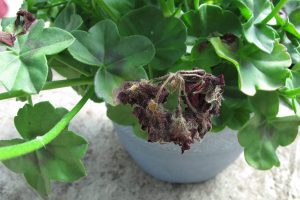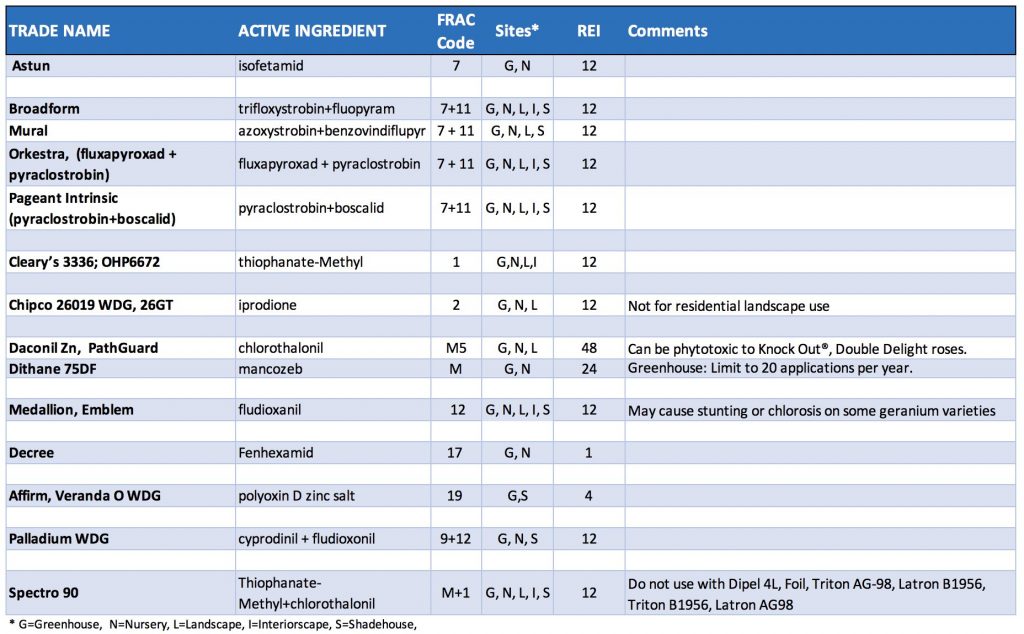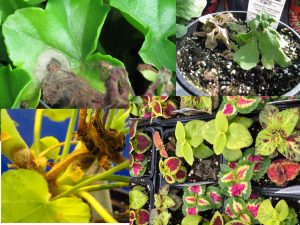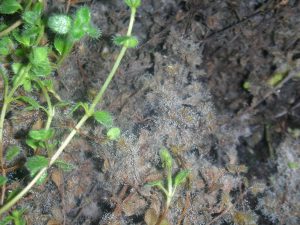Gray mold (causal agent = Botrytis cinerea) is one of the most common diseases affecting bedding plants. Host commonly include (but are not limited to): begonia, carnation, chrysanthemum, cyclamen, geranium, impatiens, marigold, million bells, petunia, vinca and zinnia. Fortunately, gray mold is one of the easiest diseases to manage. By changing cultural conditions that are unfavorable to fungal growth, the disease can be successfully controlled.
Symptoms and Signs
The proper diagnosis is necessary prior to undertaking any control strategy. Because gray mold affects numerous host plants, care must be taken in examining affected plants. Symptoms of gray mold depend upon the type of host and the type of environmental conditions. Commonly observed symptoms include: bud blast, leaf spots, flower blight, stem canker, and/or crown rot, with plant death resulting (Fig. 1). Infected tissue is soft and brown, and may appear water-soaked. A key sign of Botrytis infection is the proliferation of gray mold covering the diseased plant (Fig. 2).
- Figure 1. Symptoms of botrytis include leaf spot, blight, cankering and death.
- Figure 2. Gray-brown fungal growth is a key diagnostic sign and consists of hyphae and hundreds of thousands of spores (conidia).

Figure 3. Flowers are often the first part of the plant infected and can lead to more severe infections of the entire plant.
Infection often begins at the site of the flower or bud (Fig. 3). Flower blight of bedding plants is one of the first symptoms of this disease. The fungus establishes itself in the petals Infections are most common in the lower canopy of the plant, and in areas of the plant where humidity is high and air movement is poor. Upon infection, the fungus spreads from the flower into the pedicel/peduncle. Eventually, the fungus invades the stem, leading to plant death. Symptoms of flower or bud blast begin as irregular gray/brown spots on the petals, whereas buds turn brown and/or have a water-soaked appearance. Infected buds may not open, or they may fall off.
Leaf spot often appears in young, tender seedlings or when infected flowers petals contact the plant leaves. Leaf spots often appear water-soaked, are tan in color and have irregular margins. If warm temperatures and high humidity persist, the fungus can spread into the main stem and form cankers. When this occurs, plants can quickly die.
One of the key diagnostic features is the presence of the gray-brown mold growing over the affected area. The fungus will readily produce spores in 85% humidity and warm (75 degree F) temperatures, which spreads the disease. Although the sign of Botrytis is a key diagnostic feature, you must remember that Botrytis may also appear as a secondary decay fungus. Care must be taken in observing that symptom development is consistent with Botrytis infection. If you observe unusual symptoms (e.g., wilt, angular leaf spot, deformity) of plant disease that are inconsistent with gray mold, and Botrytis is recovered, it should be assumed that Botrytis was acting as a decay agent and did not cause plant death.
Management
Despite its voracious nature, gray mold is easily controlled by cultural techniques. Upon identification of gray mold, infected plant material should be removed and disposed of. This reduces the inoculum source and minimizes the possibility of infection. Equally essential for control of this disease is manipulating the environmental conditions that contribute to the growth and sporulation of gray mold. The fungus that causes gray mold infects a wide variety of hosts found in the yard and garden (including weeds) and survives on dead plant material from the previous season. In spring, large numbers of microscopic spores (conidia) are released and spread by wind, splashing water, and human activity.
In the nursery, greenhouse, and landscape, Botrytis often appears during cool, overcast days. Temperatures of 70° to 80°F and ample moisture favor the disease, although infections may occur at
lower temperatures when plants are wet for prolonged periods. Frequent irrigation or rain promotes disease development. Lush plant growth and cultivars that have dense foliage that shade blossoms and/or fruit are most susceptible to attack.
Adequate plant spacing, maintaining the relative humidity below 85% and providing good air circulation provide excellent control for this disease. This allows rapid drying, which reduces the probability of infection. This disease can be avoided by proper plant spacing, lowered humidity and good air circulation, bypassing the need for chemical controls.
Even with the best of cultural controls, fungicides may be needed. Fungicides must be applied to foliage to effectively manage this disease. Use of Decree (Fenhexamid), and Medallion (Fludioxanil) consistently provide excellent control. Assuming resistance is not an issue, Chipco 26019 WDG, 26GT (iprodione-containing products) is very effective. These products need to be rotated with Daconil (chlorothalonil)or Dithane 75F (mancozeb)(FRAC M), or Palladium (FRAC 9+12), or a 7-11 fungicide (Broadform, Pageant, Orkestra).
Table 1. Fungicides labeled for botrytis control.

